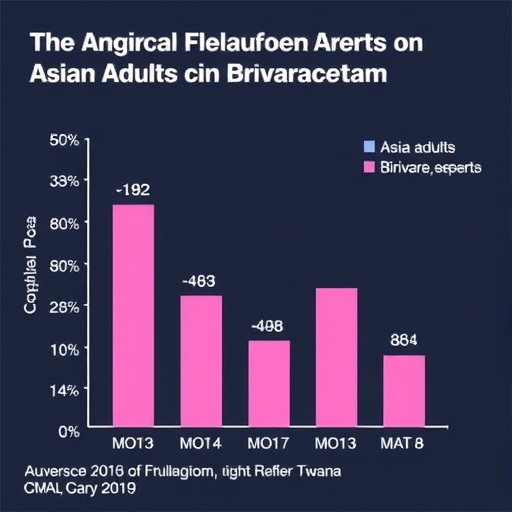The landscape of epilepsy management is evolving, and researchers are continually seeking to uncover more effective treatments to enhance patient outcomes. A recent study led by Usui et al. sheds light on the management of focal-onset seizures—particularly those experienced by adult Asian patients undergoing adjunctive therapy with the antiseizure medication brivaracetam. This research offers invaluable insights into the temporal profiles of treatment-emergent adverse events, a critical aspect of evaluating the safety and efficacy of new treatments.
In this post hoc analysis of a Phase 3, randomized clinical trial, the authors aimed to elucidate the timeline over which adverse events occur following the commencement of brivaracetam treatment. Their focus on adult Asian patients highlights a specific demographic that is often underrepresented in clinical trials, yet comprised a significant portion of the study population. As such, this research contributes to a more comprehensive understanding of treatment responses across diverse populations.
Focal-onset seizures, characterized by localized brain activity, pose a particular challenge in epilepsy management. While brivaracetam has shown promise as an adjunctive treatment in previous studies, understanding the adverse effects associated with its use is paramount. The novelty of this study lies not just in its findings, but in its detailed analysis of the time course of these effects—a factor that can significantly influence clinical decision-making.
The study identifies that adverse events can occur at varying points during the treatment course, and implications for clinical practice are substantial. Not only do these findings inform physicians about the potential risks associated with brivaracetam, but they also empower patients by providing them with relevant information regarding what to expect during their treatment journey. Knowledge is a powerful tool, and by demystifying the adverse effects timeline, this research enhances patient autonomy.
Moreover, the research emphasizes the necessity for vigilant monitoring during the initiation of treatment with brivaracetam. As adverse events are not uniformly distributed over time, healthcare providers must be aware that patients may require additional support and monitoring during certain critical periods. This nudges the medical community to adopt a more proactive approach in managing potential complications, ultimately improving patient care and satisfaction.
An interesting facet of this study is its nuanced exploration of individual patient variability in response to brivaracetam. The authors argue that the understanding of treatment-emergent adverse events is not merely a one-size-fits-all model; instead, it is influenced by diverse factors including genetics, concurrent medications, and the overall health profile of the patient. Such insights challenge the traditional paradigms that often overlook personalized medicine, underscoring the need for tailored treatment plans that consider the unique characteristics of each patient.
Furthermore, the significance of conducting this research specifically in adult Asian patients cannot be overstated. Epilepsy treatment reactions can vary greatly among different ethnic groups, influenced by genetic, environmental, and lifestyle factors. By focusing on this demographic, the study adds a robust layer of diversity to the existing literature, providing a clearer picture of the global implications of brivaracetam in epilepsy treatment.
Additionally, the researchers’ findings underline the importance of ongoing education for both healthcare providers and patients. As the landscape of epilepsy treatment continues to evolve with new medications and therapies, awareness about potential adverse effects and their management must be prioritized in medical training and patient education efforts. This will ensure that both parties are equipped with the information necessary to make informed choices regarding treatment options.
In conclusion, the research spearheaded by Usui et al. represents a significant contribution to the field of epilepsy treatment, particularly in understanding the temporal profiles of adverse events related to brivaracetam in adult Asian patients with focal-onset seizures. This study not only elucidates the nature of adverse effects but also provides a framework for more personalized, vigilant approaches in clinical practice. As the evidence-based practice continues to evolve, findings such as these serve as a reminder of the complexities involved in managing epilepsy, where every patient’s journey is unique, necessitating careful consideration of management strategies.
By focusing on treatment-emergent adverse events over time, this research empowers physicians to navigate the nuances of epilepsy management more effectively. While brivaracetam shows promise as a therapeutic option, especially when used as an adjunctive treatment, understanding its profile of side effects is equally critical in ensuring optimal patient care and long-term success in treatment.
The implications of this study extend beyond immediate clinical applications; they provide a springboard for future research aimed at refining treatment protocols and enhancing patient safety. Ongoing research efforts that build on these findings will be essential for advancing our collective understanding of epilepsy treatment and improving patient outcomes worldwide.
As the medical field looks forward to implementing these insights, researchers and practitioners alike must remain committed to pursuing excellence in epilepsy management. By prioritizing rigorous research and patient-centered approaches, the future holds promise for many individuals living with this challenging condition.
In closing, Usui et al.’s work stands as a beacon for future studies aimed at elucidating the complex relationship between treatment methods and patient responses. Recognizing the significance of the temporal dynamics of adverse events paves the way for a more thoughtful, informed approach to epilepsy care, ensuring that patient well-being remains at the forefront of all therapeutic endeavors.
Subject of Research:
Temporal Profile of Treatment-Emergent Adverse Events in Adult Asian Patients with Focal-Onset Seizures During Adjunctive Brivaracetam Treatment
Article Title:
Temporal Profile of Treatment-Emergent Adverse Events in Adult Asian Patients with Focal-Onset Seizures During Adjunctive Brivaracetam Treatment: Post Hoc Analysis of a Phase 3, Randomized Trial
Article References:
Usui, N., Zhou, D., Qin, B. et al. Temporal Profile of Treatment-Emergent Adverse Events in Adult Asian Patients with Focal-Onset Seizures During Adjunctive Brivaracetam Treatment: Post Hoc Analysis of a Phase 3, Randomized Trial. Adv Ther (2025). https://doi.org/10.1007/s12325-025-03357-7
Image Credits: AI Generated
DOI: 10.1007/s12325-025-03357-7
Keywords: brivaracetam, focal-onset seizures, epilepsy, adverse events, Asian patients, clinical trials




